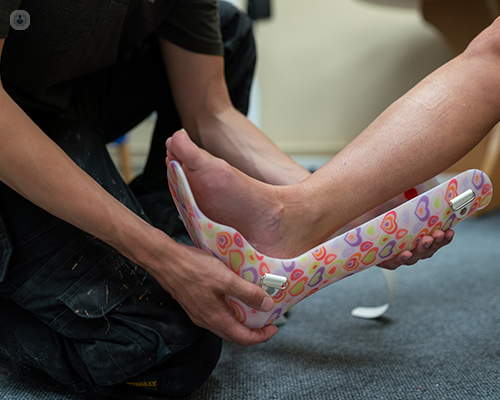Aiding recovery from foot and ankle surgery
Autore:What can patients do to aid their recovery in the weeks following surgery?
Recovery after foot and ankle surgery is a stepwise approach. The first step is for the wound to heal. This will take about 2 weeks. If you’ve had a procedure where surgeons have operated on the bone, the second step is to get the bone to heal. This can take two or three months.
The final, longest step is recovering back to a reasonable degree of functioning. These time periods are based specifically on the surgery which takes place, therefore the guidelines are not set in stone.

Something that you must keep in mind about the recovery process is the swelling that is associated with ankle surgery. I have a few tips and tricks and catchphrases in realtion to aiding healing following ankle surgery. One of these phrases is “keep it high”; you should keep your foot and ankle elevated and ideally you want the foot and ankle at the level of your heart; “get your toes above your nose”. You must keep it high for the majority of the time, especially in the first few weeks.
You should spend 45 minutes out of every hour with the foot elevated. This could be for the first two weeks of the wound healing or a little less, depending on the procedure that you had. You should only mobilise for necessity, not for pleasure.
How can I prepare beforehand and optimise healing?
During the weeks that the wound is healing, it is important to keep it dry and clean and to protect the dressings while you perform your personal hygiene. There are products available to aid foot elevation and to cover it when you’re recovering. This may be important in terms of your preparation for the surgery; having things in your home to help you elevate your foot and ankle, as well as helping to keep the operated area and/or your cast clean. It is recommended that you prepare these things before surgery.
When considering post operative care, it is also important to consider how you’re gojng to spend the first couple of weeks with the foot elevated. During this period, you don’t want to have to go up and down a lot of stairs to go to the bathroom. You want food and drink that is easily accessible to you and doesn’t require much preparation with your foot hanging down
You should also think about how to optimise the healing environment. If you’re a smoker you should stop smoking ahead of surgery. Generally, doctors recommend that patients stop smoking 3 months before their surgery and resist smoking until the bone heals. Evidence sugggests that smoking inhibits wound and bone healing.
Diabetic patients are encouraged to have their blood sugars under god control. A blood test named HbA1C can demonstrate results. It gives an idea of how well controlled your diabetes is. Evidence suggests that poorly controlled diabates is associated with wound healing problems as well as bone healing problems.
While elevating, it is important to not have the knee above the foot and ankle when you’re trying to control the swelling because the blood supply will have to go uphill and then back downhill.
Crutches or frames are useful for mobilising. However, these are difficult for people who do not have strong body strength and can be limiting. There are other products available such as knee crutches or a knee scooters which allow more indpendence. However, the foot is below the hip and the knee is not elevated while using these so you must be careful to avoid excessive swelling.
Is there anything that should be avoided during this period?
After the local anesthetic block wears off following the procedure, it is essential to monitor your painkillers regularly for about the first five days. Depending on procedure, the length of time you’ll need regular painkillers for will vary but after the intial period, you won’t require painkillers as frequently.
If you are getting any additional throbbing pain and discolouration in your toes, this is usually because the foot and ankle have been down for too long. The foot needs to be elevated and you should avoid having it down.
Icing the foot is recommended. You shouldn’t add the ice pack directly to the skin; you should apply it as ice in a bag or a cold compress to avoid it directly touching the skin .
Additionally, it is recommended to avoid smoking to help the wounds heal as much as possible and to ensure that blood sugar levels are under good control (if you’re a diabetic).

How long is bed rest required following foot and ankle surgery?
Strict digress is rarely mentioned in relation to recovery. For the first few weeks it is important to keep the foot elevated but not to be bed bound as that can increase the chance of medical complications. It increases your risk of developing potentially life threatening clots in the leg.
It is crucial to avoid being completely immobile. Doctors will encourage patients to look out for serious complications following the first few weeks of surgery, such as infections and clots which fortunately, are quite rare.
If you have a fever and experience redness coming up past your dressings, you must it seek medical attention. Additionally, if your calf gets swollen, if you get shortness of breath or chest pain that could be an indicator of a clot in the leg or the lung.
After surgery, the risk of an infection is a little lower, however clot risk continues and seems to stabilise from six weeks onwards. You may be given some injections or tablets to thin the blood.
When being considered for foot or ankle surgery, a clot risk assessment will take place. You and your clinician will make a decision whether or not it is appropriate to administer medication, alongisde other mechanical things such as stockings or pumps, to reduce the risk of a clot developing.
If you are considering foot or ankle surgery and would like to book an appoointment with Mr Koç, you can do so through his Top Doctors profile today.


